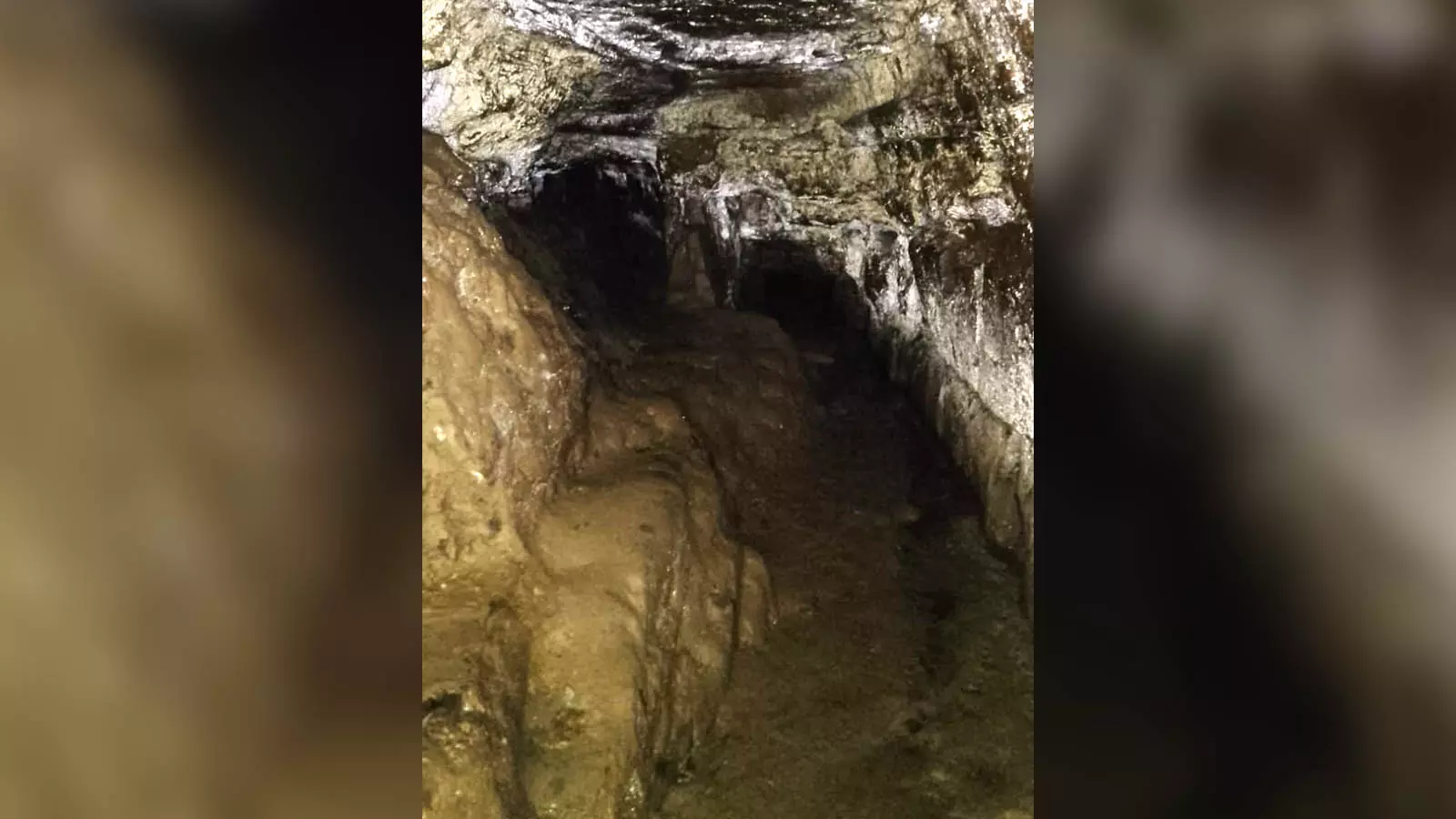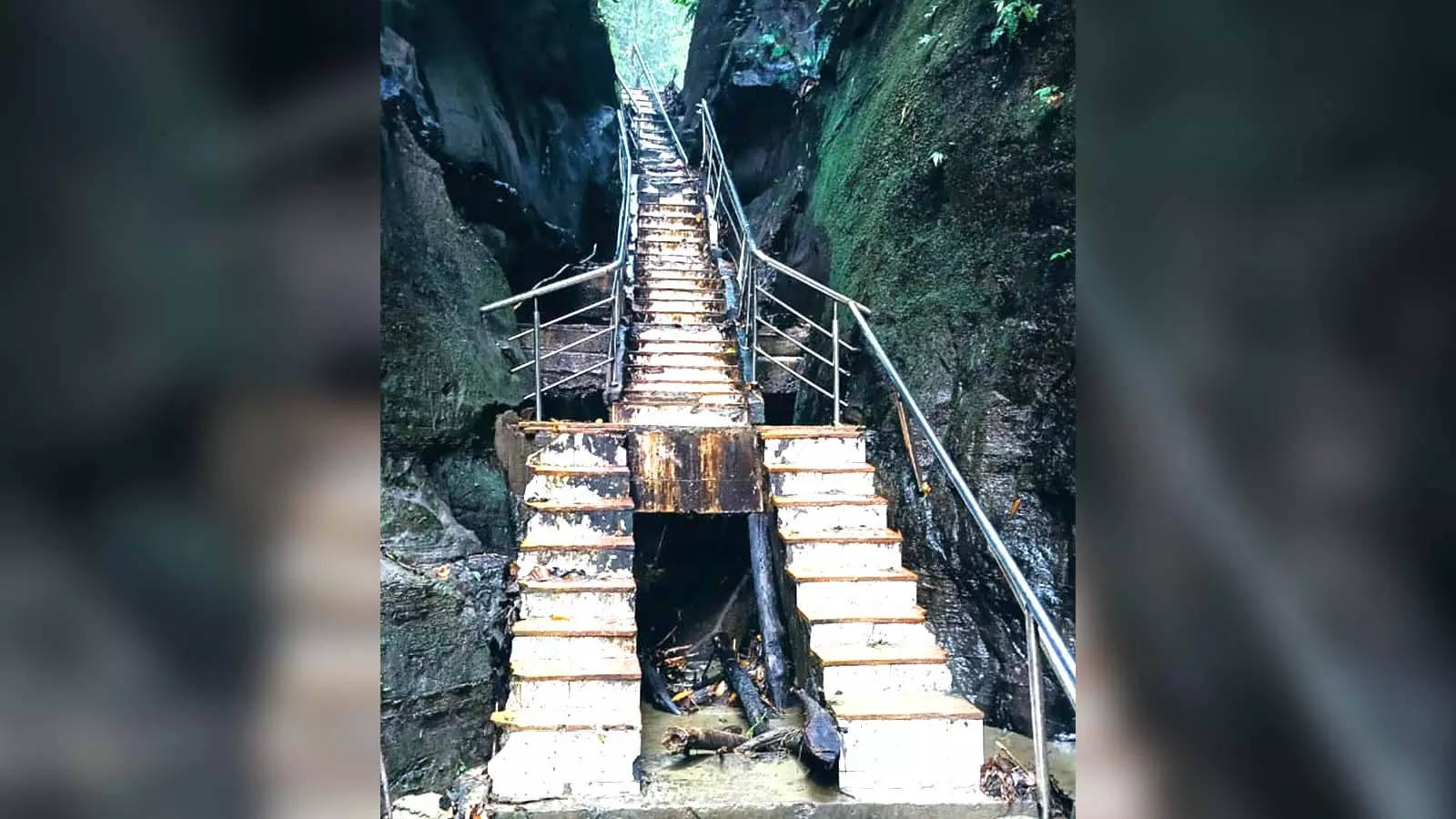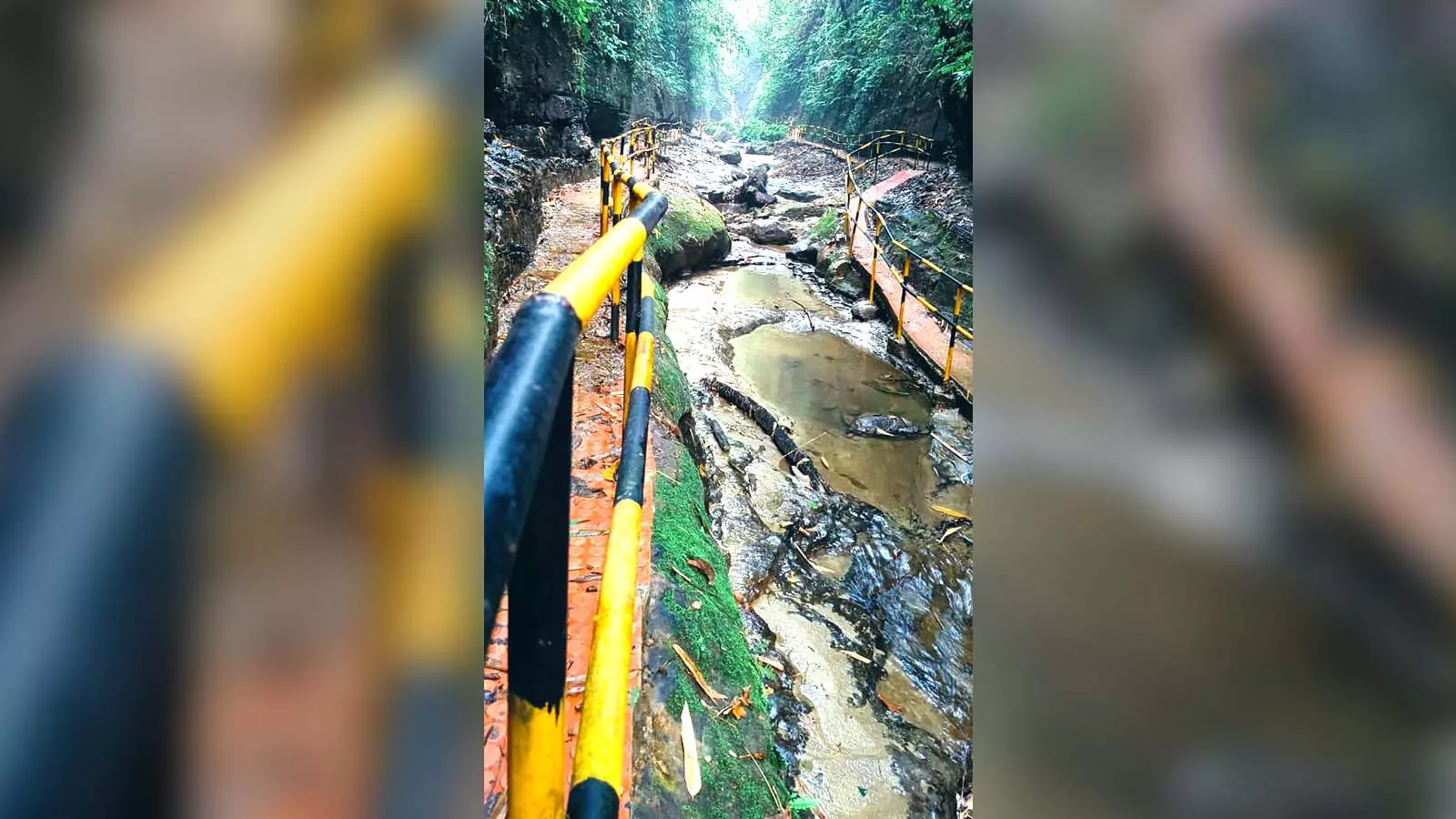
- Home
- India
- World
- Premium
- THE FEDERAL SPECIAL
- Analysis
- States
- Perspective
- Videos
- Sports
- Education
- Entertainment
- Elections
- Features
- Health
- Business
- Series
- In memoriam: Sheikh Mujibur Rahman
- Bishnoi's Men
- NEET TANGLE
- Economy Series
- Earth Day
- Kashmir’s Frozen Turbulence
- India@75
- The legend of Ramjanmabhoomi
- Liberalisation@30
- How to tame a dragon
- Celebrating biodiversity
- Farm Matters
- 50 days of solitude
- Bringing Migrants Home
- Budget 2020
- Jharkhand Votes
- The Federal Investigates
- The Federal Impact
- Vanishing Sand
- Gandhi @ 150
- Andhra Today
- Field report
- Operation Gulmarg
- Pandemic @1 Mn in India
- The Federal Year-End
- The Zero Year
- Science
- Brand studio
- Newsletter
- Elections 2024
- Events
How Chabimura in Tripura is moving from terrorism to tourism

Dilip Jamatia’s (name changed) chest swells with pride as he narrates to tourists the legends associated with the ancient rock-cut sculptures carved on mountain walls along the Gomati River in Tripura’s tribal hinterlands.These archaeological marvels offer a tangible link to his community’s glorious past, a heritage, he was once made to believe, could be protected only through barrels...
Dilip Jamatia’s (name changed) chest swells with pride as he narrates to tourists the legends associated with the ancient rock-cut sculptures carved on mountain walls along the Gomati River in Tripura’s tribal hinterlands.
These archaeological marvels offer a tangible link to his community’s glorious past, a heritage, he was once made to believe, could be protected only through barrels of Kalashnikov.
Terrorism to tourism
It was this belief because of which he gravitated towards insurgency. He started working as an overground member of the National Liberation Front of Tripura (NLFT) that envisaged establishing an independent Tripuri nation, rooted in Tripuri nationalism, through armed struggle.
“How wrong I was,” Dilip thinks as he reflects on the past while steering his tourist boat through the meandering river. It is not terrorism but tour-ism that is key to his community’s socio-economic upliftment and protection of rich heritage, he realises now.

Numismatist and historian Jahar Acharjee in one of his writings said the rock-cut sculptures were the creation of some soldiers who were hiding in the nearby cave to escape Muslim attack in the 15th century.
Dilip is presently associated with the Hachwk Mwtai Self Help Group (SHG) that manages Chabimura tourist properties as part of a tourism development project, a joint initiative of the Tripura government and the Asian Development Bank.
Also read | How Neanderthal genes, ancient migrations, and caste shaped a billion people
The SHG has 45 trained members, who are involved in various tourism-related activities in the area, said Manik Jamatia, the vice-president of the group. He admitted, however, that a few of its members had a militant past.
Until about a decade ago, Chabimura was completely inaccessible to the outside world being in the control of the NLFT militants, pushing to obscurity the chiselled-history of the area, also known as Devtamura (hills of God). Mura means hill in Kokborok, a Tibeto-Burman language that local Jamatia and Riang tribes primarily speak.
The hills of God
There are 37 sculptures of Hindu deities like Durga, Mahisasur Mardini, Shiva, Ganesha, Kartikeya and Vishnu on the stone walls of Kalajhari Hills on the eastern bank of Gomati River.
The tallest of all the sculptures is that of Mahishasurmardini, carved on a panel which is 10.70-metre high and 7.70-metre wide at a height of over 10 metres from the river bed. The locals worship the deity as Chakrak-Ma.
The round-faced deity has ten arms. In the image on the monolith, she is seen holding weapons in her arms, except in one that holds the hair of the demon king. Over the centuries, intricate artwork has faded making weapons hardly visible.
Also read | The wanderers and witnesses of history
Many panels did not last the vagaries of time and have weathered and eroded to the extent that they are now difficult to discern, Manik Jamatia lamented.
It is not yet clear as to who has chiseled these sculptures. While some scholars date the carvings to the 8th or 11th-12th centuries, others believe they were sculpted in the 15th century.
Numismatist and historian Jahar Acharjee in one of his writings said the rock-cut sculptures were the creation of some soldiers who were hiding in the nearby cave to escape Muslim attack in the 15th century.

Dhanya Manikya built many temples, including the famous Tripura Sundari Temple in Udaipur, located some 30 kilometres from Chabimura.
His account is consistent with a local lore Jamatia narrated to The Federal. As per the legend, Dhanya Manikya, who ruled Tripura from 1463 to 1515 CE had taken shelter in a cave on the bank of the river during a war with a Muslim ruler.
“At night he had a divine providence that he should offer pujas to deities to become victorious. After the puja was completed, the river washed away the camps of Muslim soldiers erected on the other bank of the river, inflicting heavy losses. Needless to say, Dhanya Manikya emerged victorious,” he narrated the story passed on to him by his grandfather.
Chabimura’s legends
According to the historical chronicle of Tripura, Husain Shah, the Nawab of Bengal, invaded Tripura thrice during Dhanya Manikya reign. On all three occasions, the Nawab was defeated and the Tripura kingdom was expanded to Eastern Bengal taking control of the entire Comilla and parts of Sylhet, Noakhali and Chittagong regions.
Dhanya Manikya built many temples, including the famous Tripura Sundari Temple in Udaipur, located some 30 kilometres from Chabimura.
Many historians like Panna Lal Roy claimed that there is no historical evidence in support of the claim that the soldiers of the Manikya dynasty sculpted the stone panels. He stressed the need for more research to find as to who could be credited for these works.
For local residents, what matters more is the Tripura government’s recent decision to revisit the history of the place to promote tourism in the area.
The tourism push
The ADB is investing Rs 67.76 crore in upgrading infrastructure and promoting eco-tourism in Chabimura and surrounding areas.
A parcel of 20 acres of land has been identified for planned interventions for developing eco accommodation, river protection structures along the east bank of the river and landscaping of the open field with the basic facilities and amenities for the tourists, according to a report prepared by the Tripura Tourism Development Corporation Limited (TTDCL) for the ADB in April this year.
The project will also include promotion of two prominent man-made lakes i.e, Fatik Sagar and Amar Sagar, located in the Amarpur town; a temple of Goddess Mangal Chandi situated at the southern bank of Amar Sagar Lake, which was constructed during 15th century, according to the report ac-cessed by The Federal.
The temple is unique in itself as it showcases both Hindu and Buddhist religious beliefs.
“Our SHG was formed in 2018 to manage tourism activities in the area. But lack of infrastructure like roads and accommodation facilities turned out to be a bottleneck,” said Biplab Jamatia, another member of the self-help group.
Things started to look up after the road-connectivity with state capital Agartala was improved in 2023. “Now tourists can visit the place even in the rainy season,” he said.
From November to January last year, the area got a monthly tourist footfall of around 300 people, according to Biplab. He said they charge Rs 150 per person for boating and sightseeing, according to Biplab. The area, he says, has the potential to draw more people and for that it has to find its rightful place in the country's map of archaeological wonders.
The SHG runs a three-room cottage in the area.
Once the ADB funded project is completed, the area is expected to get a further facelift, and that will supplement the local economy in a big way, said Manik Jamatia.
Anticipating the prospect, he says, they are now planning to upgrade their SHG into a multi-purpose cooperative society to widen its area of operation.
The government is building log-houses for the tourists as part of its tourism development project. “We plan to operate and manage them. But we can take part in the bidding for the lease only if our SHG is upgraded.”
There are two tribal villages — Debbari and Chapiya — in the area. They have a combined population of about 1,500 and have around 400 families.
Traditional farming and rubber plantations are the main source of income in the area.
“Ever since tourism started slowly picking up following the return of peace in the area, it has started supplementing our yearly income,” Manik said.
A family earns around Rs 1 to 1.5 lakh annually on an average from rubber plantation, he said.
“Locals are now opening up homestays, eateries and shops to cater to the needs of the tourists. Our SHG members provide boat-ride service, act as guides and also run the three-room cottage,” he said, hoping that the scale of tourism activities will significantly increase once the project is completely materialised as Chabimara, dotted with waterfalls, caves and other natural features offer a breathtaking landscape.
The TTDCL in its report to the ADB said that the project will ensure that the maximum benefits reach the scheduled tribe households and for the purpose a specific action plan for indigenous peoples is proposed.
The action plan, according to the report, will carry out the following specific activities:
(i) a baseline survey will be conducted for identification of potential indigenous peoples’ households within a radius of 2 kms. from the Chabimura destination for carrying out probable income generation activities related to tourism;

(ii) proposed benefits to indigenous peoples’ households will be shared and monitored;
(iii) contractual provisions will ensure that scheduled tribe house-holds in the project coverage area at Chabimura will benefit from development and construction of tourism related infrastructure and other associated amenities by getting various types of livelihood scopes, including opportunity to work as construction labours during project related civil work, selling of their indigenous products to the visiting tourists etc. which will provide them with a supplementary income source too.
Chabimura, which literally means hills of pictures, has now become a beacon of hope, even for those who not too long ago thought of wielding guns to bring about a change.
